Mukaish and Kamdani Metal Threadwork
Mukaish and Kamdani Metal Threadwork: A Gleam of Mughal Legacy
Mukaish and Kamdani Metal Threadwork are distinct forms of South Asian embroidery, both utilizing metallic threads, but with some differences in their techniques and application. Among the many exquisite textile traditions of Pakistan, Mukaish, originating from the term Muqayyash also known as badla, and Kamdani metal threadwork stands out as a radiant symbol of artistic heritage. This centuries-old craft, introduced to the region through Persian and Central Asian Muslim influences, as the names indicate, and refined during the Mughal era, involves the meticulous application of metallic threads—traditionally silver—onto fine fabrics like silk, chiffon, and organza.
Together, Mukaish (delicate metallic dots) and Kamdani (more intricate motifs) form a shimmering tapestry of light and texture. Once reserved for royalty, this hand-embellished work now plays a central role in bridal couture, formal attire, and luxury fashion across Pakistan.
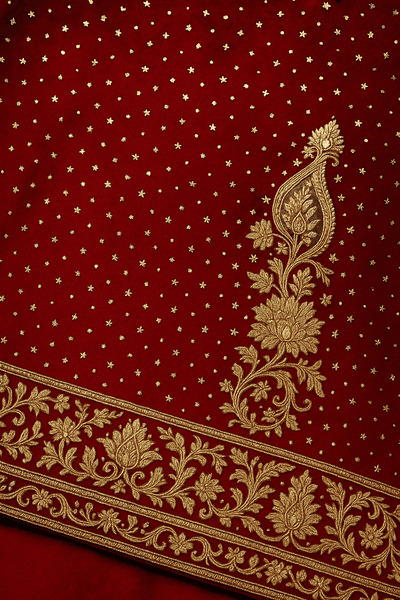 Mukaish and Kamdani Embroidery
Mukaish and Kamdani EmbroideryMukaish and Kamdani Metal Threadwork-What are Mukaish & Kamdani?
The term Mukaish generally refers to the dot-like stitches that sparkle like scattered dew, while Kamdani is used for more intricate motifs such as vines, paisleys, and stylized florals. Though often used interchangeably today, traditional artisans still recognize a difference in technique and density.
Kamdani is a form of hand embroidery that involves twisting thin metallic threads into tiny patterns and embedding them directly onto fabric. The result is a stunning shimmer created by small metal stars, dots, and motifs, which catch the light in movement. These delicate embellishments—once reserved for royalty—have become a symbol of grace and tradition in Pakistani fashion, especially in formal and bridal attire.
Unlike more heavily encrusted embroidery techniques, Kamdani is known for its subtle shimmer and understated elegance, making it both timeless and versatile.
Most of the work is done on undyed white fabric and colors are added by dyeing after the work has been completed as per the wish of the customer.
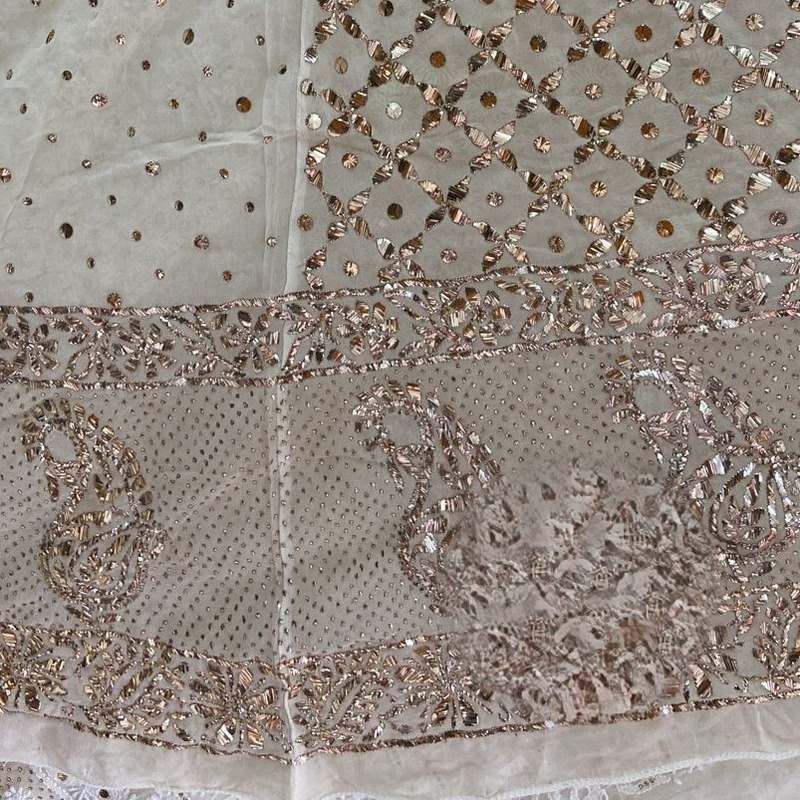
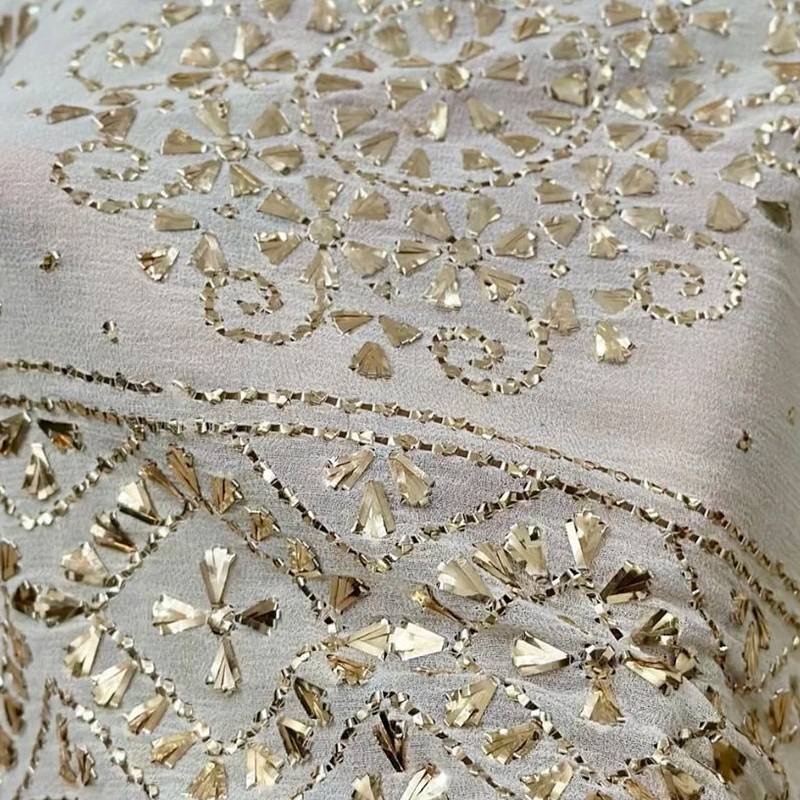
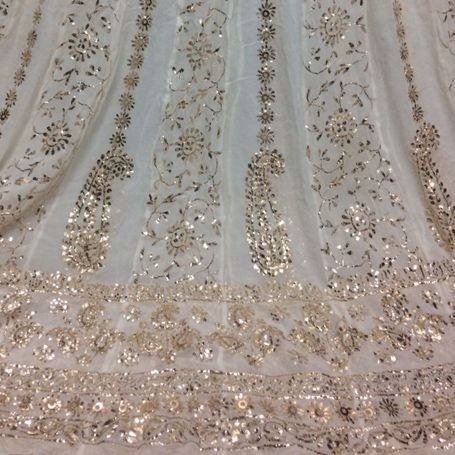
Mukaish and Kamdani Metal Threadwork-Historical Roots in the Mughal Era
During the Mughal period, textile arts flourished under royal patronage. Kamdani and Mukaish threadwork became especially prominent in garments worn by nobility, including queens and princesses who favored intricately adorned shararas, farshi ghararas, and angarkhas. It was during this time that craft guilds flourished in South-Asian cities like Lucknow, Lahore and Multan, where Persian-inspired artistry fused with local skills, forming distinct regional expressions of Kamdani that we still see today. Workshops in cities like Lahore and Multan became known for their craftsmanship, merging Persian-influenced artistry with South Asian aesthetics.
Even after the decline of the Mughal Empire, these traditions endured in what is now Pakistan, passed down through generations of artisans dedicated to preserving the finesse and cultural identity of their craft.
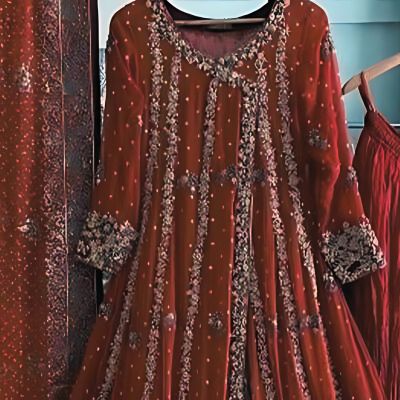 mukaish-kamdani-metal-threadwork-outift
mukaish-kamdani-metal-threadwork-outift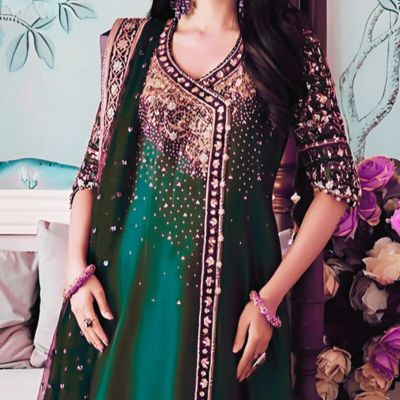 mukaish-kamdani-metal-threadwork-outift
mukaish-kamdani-metal-threadwork-outift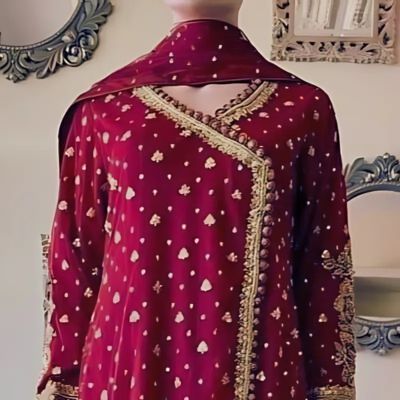 mukaish-kamdani-metal-threadwork-outift
mukaish-kamdani-metal-threadwork-outiftMukaish and Kamdani Metal Threadwork-Fabrics Used
Mukaish & Kamdani require fabrics that can both support the weight of metallic threadwork and drape elegantly to highlight the embroidery's sparkle. Commonly used fabrics include:
- Silk – prized for its natural sheen and richness, silk complements the metallic highlights of Kamdani beautifully.
- Chiffon – light and sheer, chiffon allows the reflective elements to appear as if they are floating on air.
- Georgette – with its slightly textured surface, georgette provides a good grip for the metallic threads.
- Organza – a stiff, transparent fabric ideal for holding heavier motifs, often used for dupattas.
- Net and tissue fabrics – sometimes used in bridal layering to enhance texture and depth.
- Lawn and Muslin - Lighter fabrics mainly for Kamdani embroidery.
The careful selection of fabric plays a crucial role in how the embroidery interacts with light and movement.
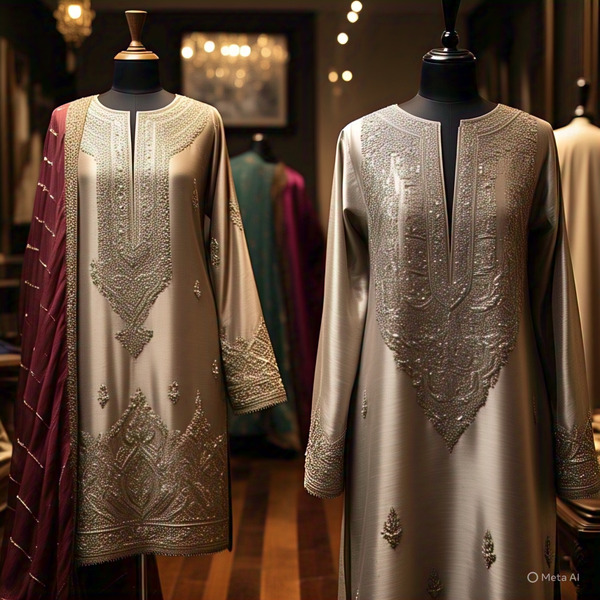 Mukaish Kamdani Metal Threadwork-Silk
Mukaish Kamdani Metal Threadwork-Silk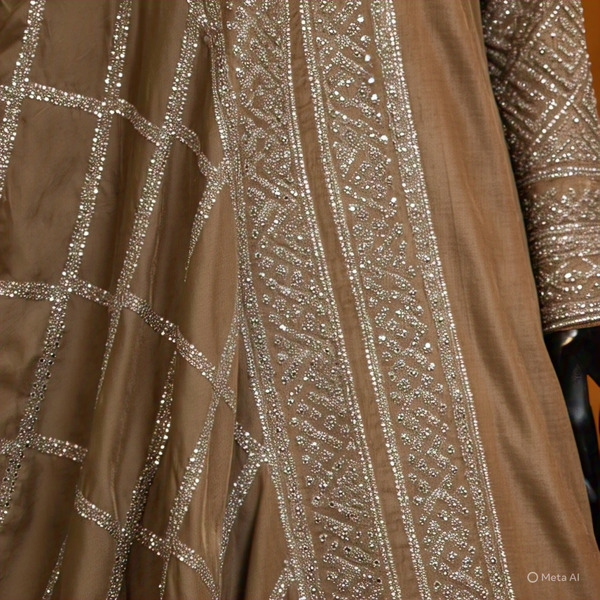 Mukaish Kamdani Metal Threadwork-Chiffon
Mukaish Kamdani Metal Threadwork-Chiffon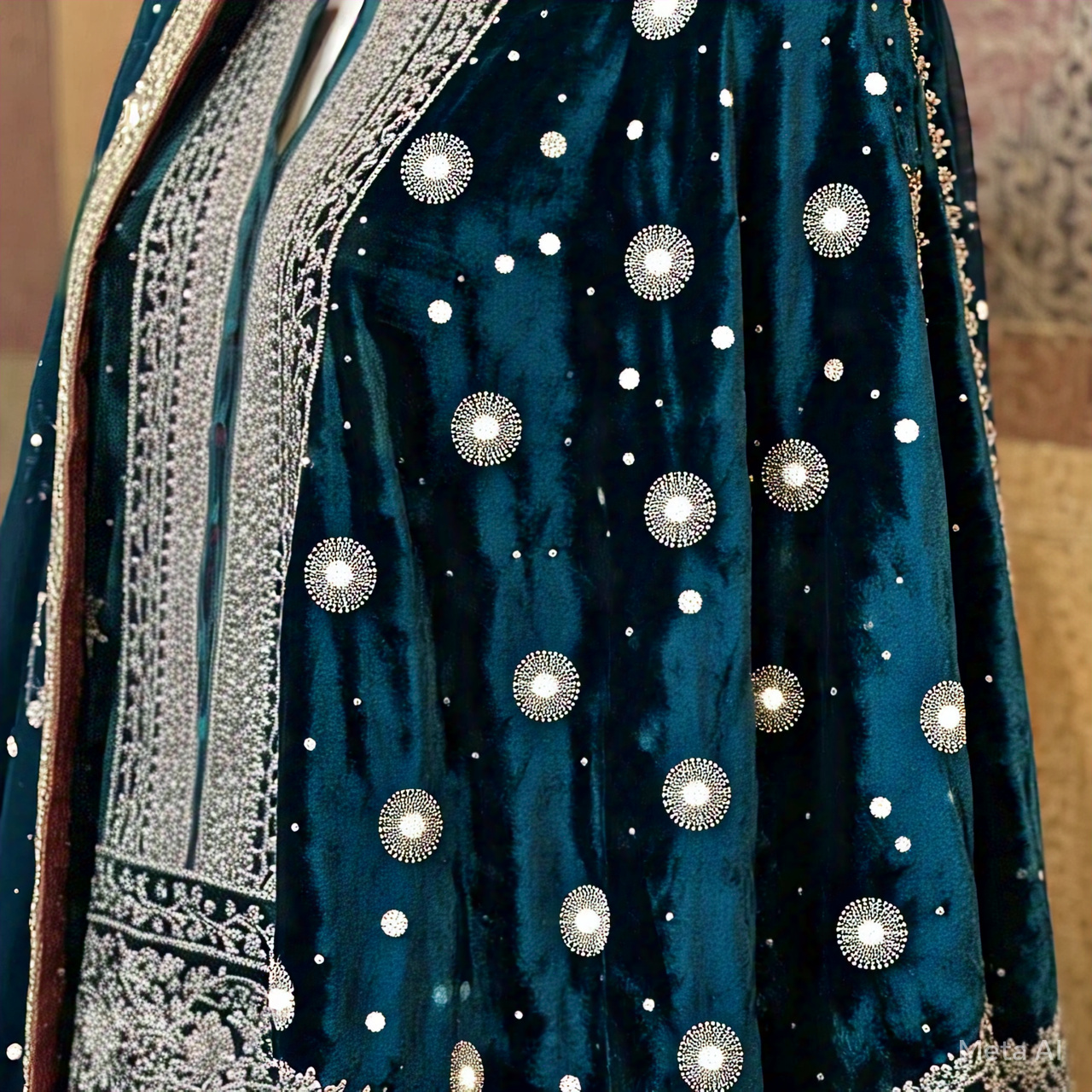 Mukaish Kamdani-Metal Threadwork-Silk
Mukaish Kamdani-Metal Threadwork-SilkMukaish and Kamdani Metal Threadwork-Metals Used: From Silver Threads to Contemporary Alloys
Traditionally, Mukaish & Kamdani was crafted using pure silver wires, known as badla, which were beaten into thin strips, then twisted into coils or hammered flat for stitching into fabric. These threads created luminous, long-lasting designs that were prized for their opulence.
In modern times, due to the rising cost of silver and changing production needs, artisans often use silver-plated copper, aluminum, or synthetic metallic foils. While the affordability and availability of these materials have made Kamdani accessible to a wider audience, many purists still seek out the older, heavier styles that use real silver or even gold threads for heirloom bridal pieces.
Mukaish and Kamdani Metal Threadwork-Symbolism and Motifs
Kamdani motifs often carry symbolic meaning rooted in Islamic and Central Asian art traditions. Common motifs include:
- Stars (Sitara) – representing divine light and guidance.
- Dots (Mukaish) – symbolizing purity, clarity, and celestial simplicity.
- Paisleys – signifying fertility and abundance.
- Vines and florals – representing paradise, echoing the garden themes in Mughal architecture.
The placement and repetition of these motifs are not random—they are often guided by traditional patterns and symmetry inspired by Islamic geometric design principles.
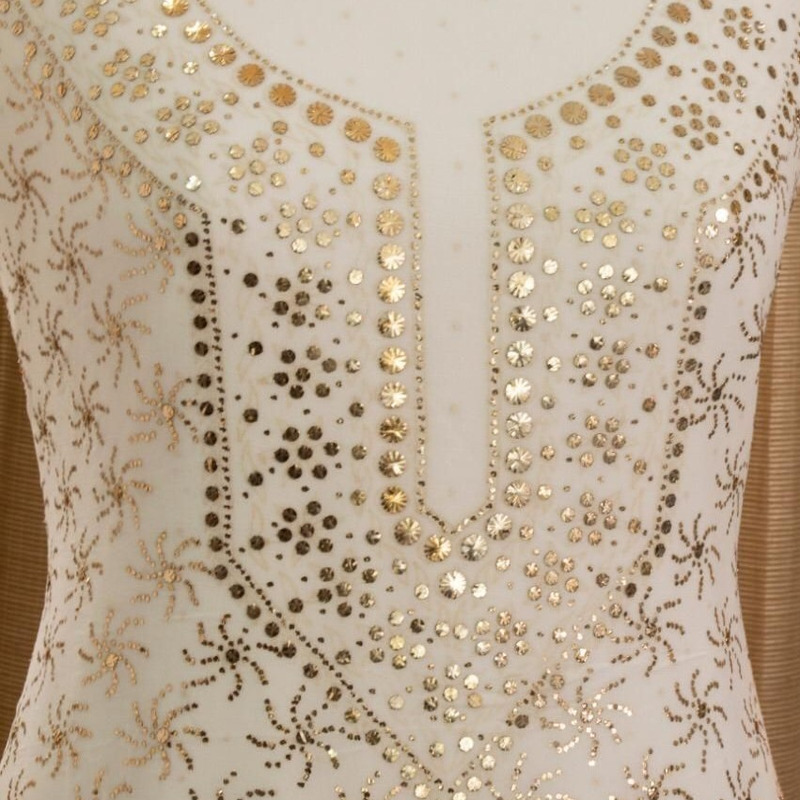 Mukaish Kamdani-Metal Threadwork-Outfit
Mukaish Kamdani-Metal Threadwork-Outfit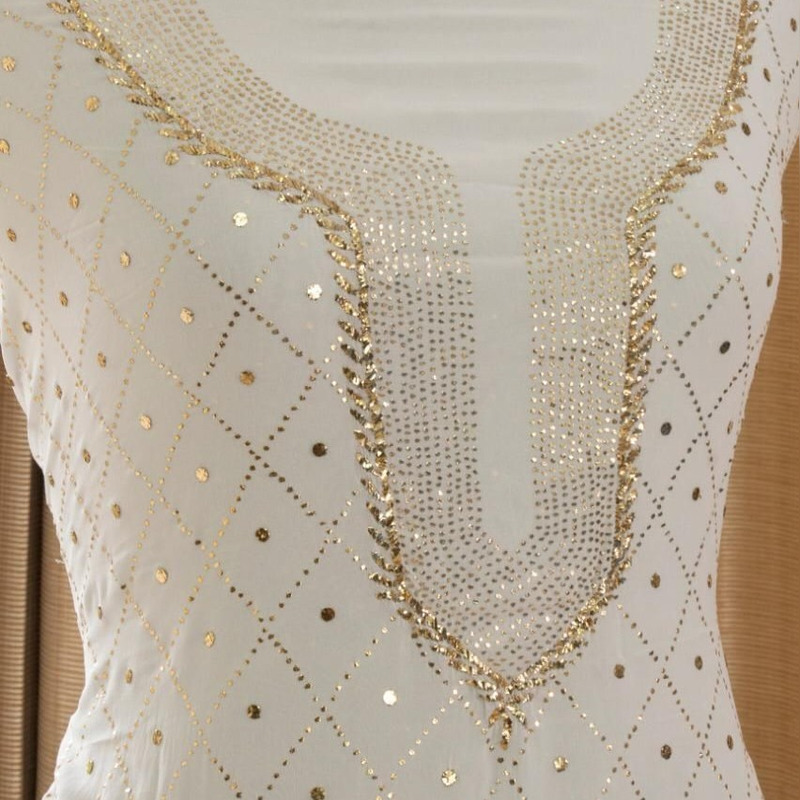 Mukaish Kamdani-Metal Threadwork-Outfit
Mukaish Kamdani-Metal Threadwork-Outfit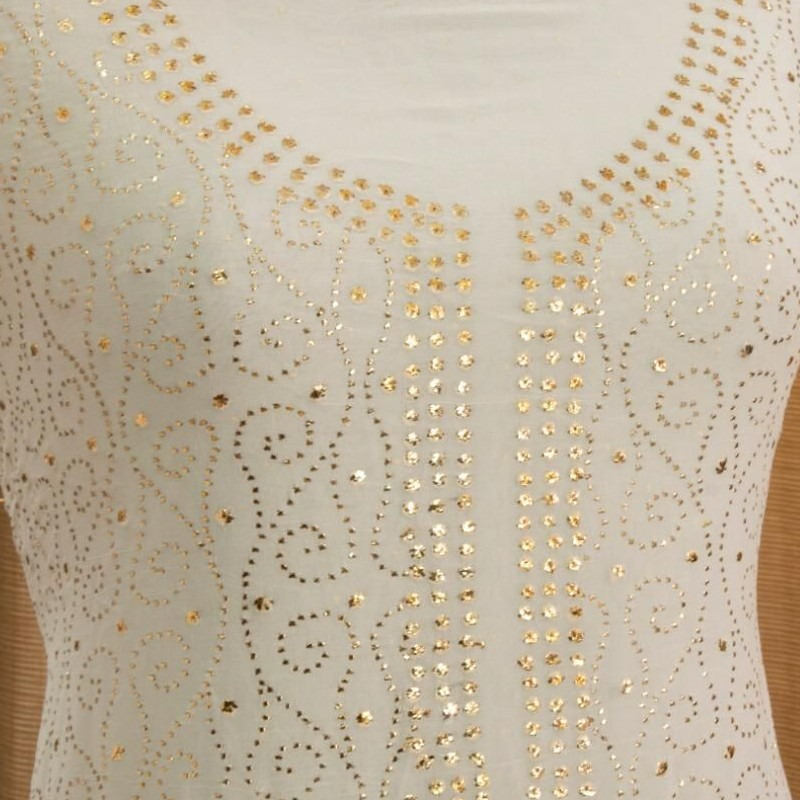 Mukaish Kamdani-Metal Threadwork-Outfit
Mukaish Kamdani-Metal Threadwork-OutfitMukaish and Kamdani Metal Threadwork-Use in Bridal Wear and Modern Adaptations
In contemporary Pakistan, Mukaish & Kamdani embroidery continues to play a central role in bridal fashion—used in lehngas, ghararas, dupattas, and anarkalis, often in conjunction with other heritage embellishments like zardozi, dabka, gota, and kora. Kamdani lends a delicate luminosity to heavier pieces, adding detail without excess weight.
Leading Pakistani designers often incorporate Mukaish & Kamdani into couture collections, showcasing its elegance on national and international runways. This has helped revive interest in the craft and encouraged new training programs for young artisans.
Beyond bridalwear, Mukaish & Kamdani embroidery is also featured in luxury pret, particularly in shirts, kaftans, and dupattas designed for Eid and festive occasions. With minimal silhouettes and monochrome palettes, modern interpretations allow Mukaish & Kamdani to shine in a more versatile wardrobe.
Mukaish and Kamdani Metal Threadwork-Regional Craft Hubs and Artisan Lineages
Some of the most skilled artisans of this craft reside in Lahore, Karachi, and southern Punjab, where family-run embroidery houses have practiced the art for generations. In many cases, knowledge is passed down through oral traditions and hands-on apprenticeships, rather than formal institutions.
Despite the fact that due to mechanization and fast fashion, many artisans have left the craft, however, with increasing demand for ethical fashion and handcrafted luxury, initiatives by designers have revitalized Mukaish & Kamdani embroidery, ensuring that this precious tradition continues to sparkle in the future.
Mukaish and Kamdani Metal Threadwork-A Living Legacy
Mukaish & Kamdani embroidery is more than a decorative technique—it is a living legacy of cross-cultural craftsmanship, resilience, and beauty. From Mughal palaces to modern bridal trousseaus, it tells a story of heritage that refuses to fade. Its shimmering elegance, stitched by hand, speaks of the past even as it graces the future.
- Home
- Pakistani Bridalwear
- Mukaish and Kamdani


